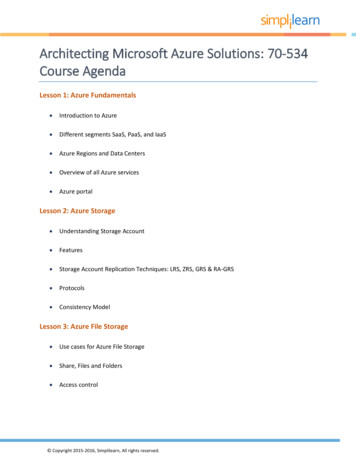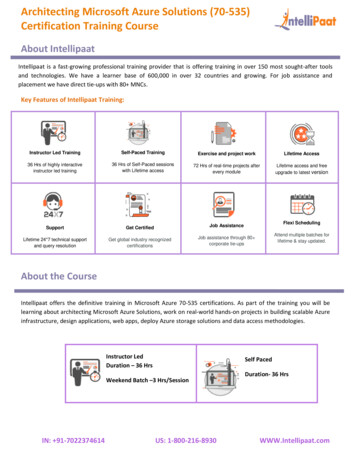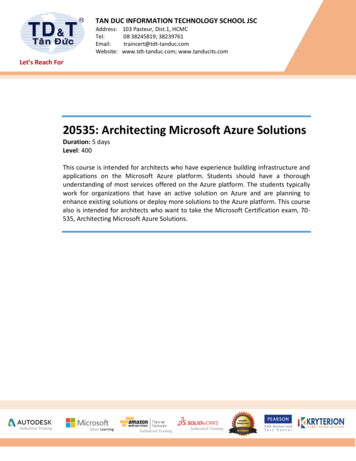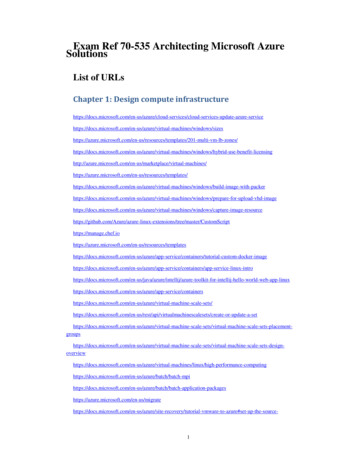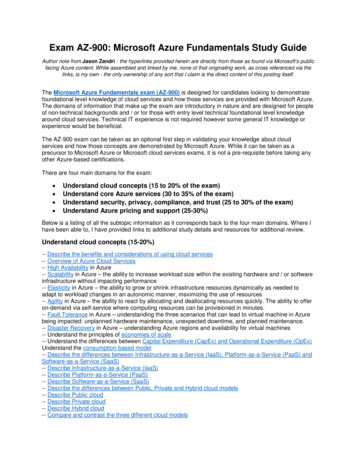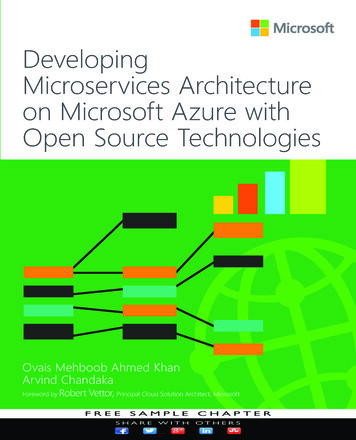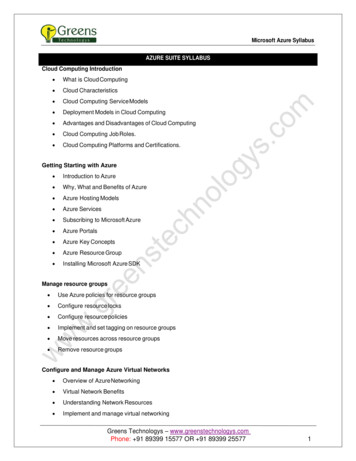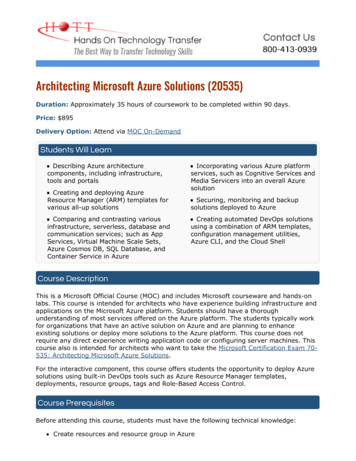
Transcription
Architecting Microsoft Azure Solutions (20535)Duration: Approximately 35 hours of coursework to be completed within 90 days.Price: 895Delivery Option: Attend via MOC On-DemandStudents Will LearnDescribing Azure architecturecomponents, including infrastructure,tools and portalsCreating and deploying AzureResource Manager (ARM) templates forvarious all-up solutionsComparing and contrasting variousinfrastructure, serverless, database andcommunication services; such as AppServices, Virtual Machine Scale Sets,Azure Cosmos DB, SQL Database, andContainer Service in AzureIncorporating various Azure platformservices, such as Cognitive Services andMedia Servicers into an overall AzuresolutionSecuring, monitoring and backupsolutions deployed to AzureCreating automated DevOps solutionsusing a combination of ARM templates,configuration management utilities,Azure CLI, and the Cloud ShellCourse DescriptionThis is a Microsoft Official Course (MOC) and includes Microsoft courseware and hands-onlabs. This course is intended for architects who have experience building infrastructure andapplications on the Microsoft Azure platform. Students should have a thoroughunderstanding of most services offered on the Azure platform. The students typically workfor organizations that have an active solution on Azure and are planning to enhanceexisting solutions or deploy more solutions to the Azure platform. This course does notrequire any direct experience writing application code or configuring server machines. Thiscourse also is intended for architects who want to take the Microsoft Certification Exam 70535: Architecting Microsoft Azure Solutions.For the interactive component, this course offers students the opportunity to deploy Azuresolutions using built-in DevOps tools such as Azure Resource Manager templates,deployments, resource groups, tags and Role-Based Access Control.Course PrerequisitesBefore attending this course, students must have the following technical knowledge:Create resources and resource group in Azure
Manage users, groups, and subscriptions in an Azure Active Directory instanceBuild an Azure Virtual Machine with related resourcesManage containers and blobs stored in an Azure Storage accountCreate App Service Plans and manage apps related to the planConfigure an Azure Virtual Network and enable S2S and P2S connectivityProtect networked application components using Network Security GroupsAutomate everyday Azure resource tasks using Azure CLI or Azure PowerShellDeploy an Azure SQL, MySQL, Postgres or Cosmos database instanceMonitor existing Azure solutions using built-in metrics, Application Insights, orOperational InsightsAbout MOC On-DemandMicrosoft Official Courses On-Demand uses a combination of streaming video, text, labexercises and assessment checks throughout the course. MOC On-Demand courses areavailable for 90 days and recommend the following system requirements:Browser: Current version of Internet Explorer, Microsoft Edge, Google Chrome orFirefoxInternet: Broadband Internet connection of over 4MbpsScreen Resolution: 1280 x 1024 or higherCourse OverviewModule 1: Application Architecture Patterns in AzureThis module introduces and reviews common Azure patterns and architectures asprescribed by the Microsoft Patterns & Practices team. Each pattern is grouped intoperformance, resiliency, and scalability categories and described in the context of similarpatterns within the category.LessonsPattern ResourcesPerformance PatternsResiliency PatternsScalability PatternsData PatternsAfter completing this module, students will be able to:Locate and reference the Cloud Design Patterns documentation.Locate and reference the Azure Architecture Center.Describe various patterns pulled from the Cloud Design Patterns.Module 2: Deploying Resources with Azure Resource ManagerThis module establishes a basic understanding of Azure Resource Manager and the coreconcepts of deployments, resources, templates, resource groups, and tags. The modulewill dive deeply into the automated deployment of resources using ARM templates.Lessons
ARM TemplatesRole-Based Access Control (RBAC)Resource PoliciesSecurityBuilding BlocksLabsCreate Resource GroupsDeploy an Empty TemplateDeploy a Simple TemplateCleanup SubscriptionAfter completing this module, students will be able to:Create a resource group.Add resources to a resource group.Deploy an ARM template to a resource group.Filter resources using tags.Author a complex deployment using the Azure Building Blocks tools.Module 3: Building Azure IaaS-Based Server ApplicationsThis module identifies workloads that are ideally deployed using Infrastructure-as-aService services in Azure. The module focuses on the VM Scale Sets and Virtual Machineservices in Azure and how to best deploy workloads to these services using bestpractices and features such as Availability Sets.LessonsHigh AvailabilityTemplated InfrastructureDomain-Connected MachinesLabsDeploy a Virtual Machine using PowerShell DSCDeploy a Virtual Machine Scale Set using PowerShell DSCCleanup SubscriptionAfter completing this module, students will be able to:Design an availability set for one or more virtual machinesDescribe the differences between fault and update domains.Author a VM Scale Set ARM template.Join a virtualized machine to a domain either in Azure or on a hybrid network.Module 4: Creating Managed Server Applications in AzureThis module describes services that use infrastructure but manage the infrastructure onbehalf of the user instead of obfuscating the infrastructure resources. The modulefocuses on infrastructure-backed PaaS options such as Azure Service Fabric, ContainerService, and App Service Environments. The module will explore how to deploy customworkloads to these services such as an HPC batch processing task.Lessons
Infrastructure-Backed Platform-as-a-Service (PaaS)High-Performance Compute (HPC)MigrationLabsCreate Azure Container Service ClusterDeploy Docker ImageCleanup SubscriptionAfter completing this module, students will be able to:Describe the differences between App Service Environments, Service Fabric andContainer Service.Use Azure Batch to manage an HPC workload.Migrate to an Infrastructure-backed PaaS service from another IaaS service or alegacy Cloud Service.Module 5: Authoring Serverless Applications in AzureThis module describes how solutions can leverage serverless application hosting servicesin Azure to host web applications, REST APIs, integration workflows and HPC workloadswithout the requirement to manage specific server resources. The module focuses onApp Services-related components such as Web Apps, API Apps, Mobile Apps, Logic Apps,and Functions.LessonsAzure Web AppAzure FunctionsIntegrationHigh PerformanceLabsCreate Web AppDeploy Web App CodeDeploy Function App and CodeCleanup SubscriptionAfter completing this module, students will be able to:Select between hosting application code or containers in an App Service instance.Describe the differences between API, Mobile, and Web Apps.Integrate an API or Logic App with the API Management service.Design an App Service Plan or multi-region deployment for high performance andscale.Module 6: Backing Azure Solutions with Azure StorageThis module describes how many Azure services use the Azure Storage service as abacking store for other application solution in Azure. The module dives into criticalconsiderations when using Azure Storage as a supplemental service for an all-up Azuresolution.
LessonsPricingBlob StorageFilesStorSimpleLabsCreate Required Resources for a Virtual MachineCreate a VM With a Storage AccountCreate a VM With a Managed DiskCleanup SubscriptionAfter completing this module, students will be able to:Determine the ideal pricing option for Azure Storage based on a solution’srequirements.Identify performance thresholds for the Azure Storage service.Determine the type of Storage blobs to use for specific solution components.Use the Azure Files service for SMB operations.Identify solutions that could benefit from the use of StorSimple physical or virtualdevices.Module 7: Comparing Database Options in AzureThis module compares the various relational and non-relational data storage optionsavailable in Azure. Options are explored as groups such as relational databases (AzureSQL Database, MySQL, and PostgreSQL on Azure), non-relational (Azure Cosmos DB,Storage Tables), streaming (Stream Analytics) and storage (Data Factory, DataWarehouse, Data Lake).LessonsRelationalNoSQL ServicesAzure Cosmos DBData StorageData AnalysisLabsDeploy a CosmosDB Database InstanceValidate the REST APICleanup SubscriptionAfter completing this module, students will be able to:Compare and contrast various database options on Azure.Identify data streaming options for large-scale data ingest.Identify longer-term data storage options.Module 8: Networking Azure Application ComponentsThis module describes the various networking and connectivity options available forsolutions deployed on Azure. The module explores connectivity options ranging from ad-
hoc connections to long-term hybrid connectivity scenarios. The module also discussessome of the performance and security concerns related to balancing workloads acrossmultiple compute instances, connecting on-premise infrastructure to the cloud andcreating gateways for on-premise data.LessonsVNETsLoad BalancingExternal ConnectivityHybrid ConnectivityLabsCreate an ARM Template for a Linux VMDuplicate the VM ResourcesCreate a Load Balancer ResourceCleanup SubscriptionAfter completing this module, students will be able to:Describe DNS and IP strategies for VNETs in Azure.Compare connectivity options for ad-hoc and hybrid connectivity.Distribute network traffic across multiple loads using load balancers.Design a hybrid connectivity scenario between cloud and on-premise.Module 9: Managing Security and Identity for Azure SolutionsThis module discusses both security and identity within the context of Azure. Forsecurity, this module reviews the various options for monitoring security, the optionsavailable for securing data and the options for securing application secrets. For identity,this module focuses specifically on Azure Active Directory (Azure AD) and the variousfeatures available such as Multi-Factor Authentication (MFA), Managed Service Identity,Azure AD Connect, ADFS and Azure AD B2B/B2C.LessonsSecurity MonitoringData SecurityApplication Security Azure Active Directory (Azure AD)Hybrid IdentityAzure AD Application IntegrationLabsDeploy Key Vault using ARM TemplateDeploy Virtual Machine using Key Vault SecretCleanup SubscriptionAfter completing this module, students will be able to:Integrate their existing solutions with external identity providers using Azure ADB2B or B2C.Design a hybrid identity solution.Determine when to use advanced features of Azure AD such as Managed ServiceIdentity, MFA and Privileged Identity Management.
Secure application secrets using Key Vault.Secure application data using SQL Database and Azure Storage features.Module 10: Integrating SaaS Services Available on the Azure PlatformThis module introduces multiple SaaS services available in Azure that are available forintegration into existing Azure solutions. These services include Cognitive Services, BotService, Machine Learning and Media Services.LessonsCognitive ServicesBot ServicesMachine LearningMedia ServicesLabsDeploy Function App and Cognitive Service using ARM TemplateCleanup SubscriptionAfter completing this module, students will be able to:Identify when Cognitive Services, Bot Service or Machine Learning is appropriatefor their solution.Compare the various features available in Media Services and determine theappropriate features for their solution.Module 11: Integrating Azure Solution Components using Messaging ServicesThis module describes and compares the integration and messaging services availablefor solutions hosted on the Azure platform. Messaging services described include AzureStorage Queues, Service Bus Queues, Service Bus Relay, IoT Hubs, Event Hubs, andNotification Hubs. Integration services include Azure Functions and Logic Apps.LessonsEvent MessagingIntegrationIoTLabsDeploy Service Bus NamespaceDeploy Logic AppCleanup SubscriptionAfter completing this module, students will be able to:Compare Storage Queues to Service Bus Queues.Identify when to use Azure Functions or Logic Apps for integration components in asolution.Describe the differences between IoT Hubs, Event Hubs and Time Series Insights.Module 12: Monitoring and Automating Azure Solutions
This module covers the monitoring and automation solutions available after an Azuresolution has been architected, designed and possibly deployed. The module reviewsservices that are used to monitor individual applications, the Azure platform, andnetworked components. This module also covers automation and backup options toenable business-continuity scenarios for solutions hosted in Azure.LessonsApplication MonitoringPlatform MonitoringNetwork MonitoringAlertingBackupAzure AutomationConfig ManagementAuto-ScaleLabsDeploy a Chef Management Server using ARMConfigure Management ServerDeploy a VM Scale Set using Chef-Configured VMsCleanup SubscriptionAfter completing this module, students will be able to:Compare and contrast monitoring services for applications, the Azure platform, andnetworking.Design an alert scheme for a solution hosted in Azure.Select the appropriate backup option for infrastructure and data hosted in Azure.Automate the deployment of future resources for backup recovery or scalingpurposes.Hands On Technology TransferThe Best Way to Transfer Technology Skills1 Village Square, Suite 814 Fletcher StreetChelmsford, MA 01824Copyright 2020
existing solutions or deploy more solutions to the Azure platform. This course does not require any direct experience writing application code or configuring server machines. This course also is intended for architects who want to take the Microsoft Certification Exam 70-535: Architecting Microsoft Azure Solutions.
